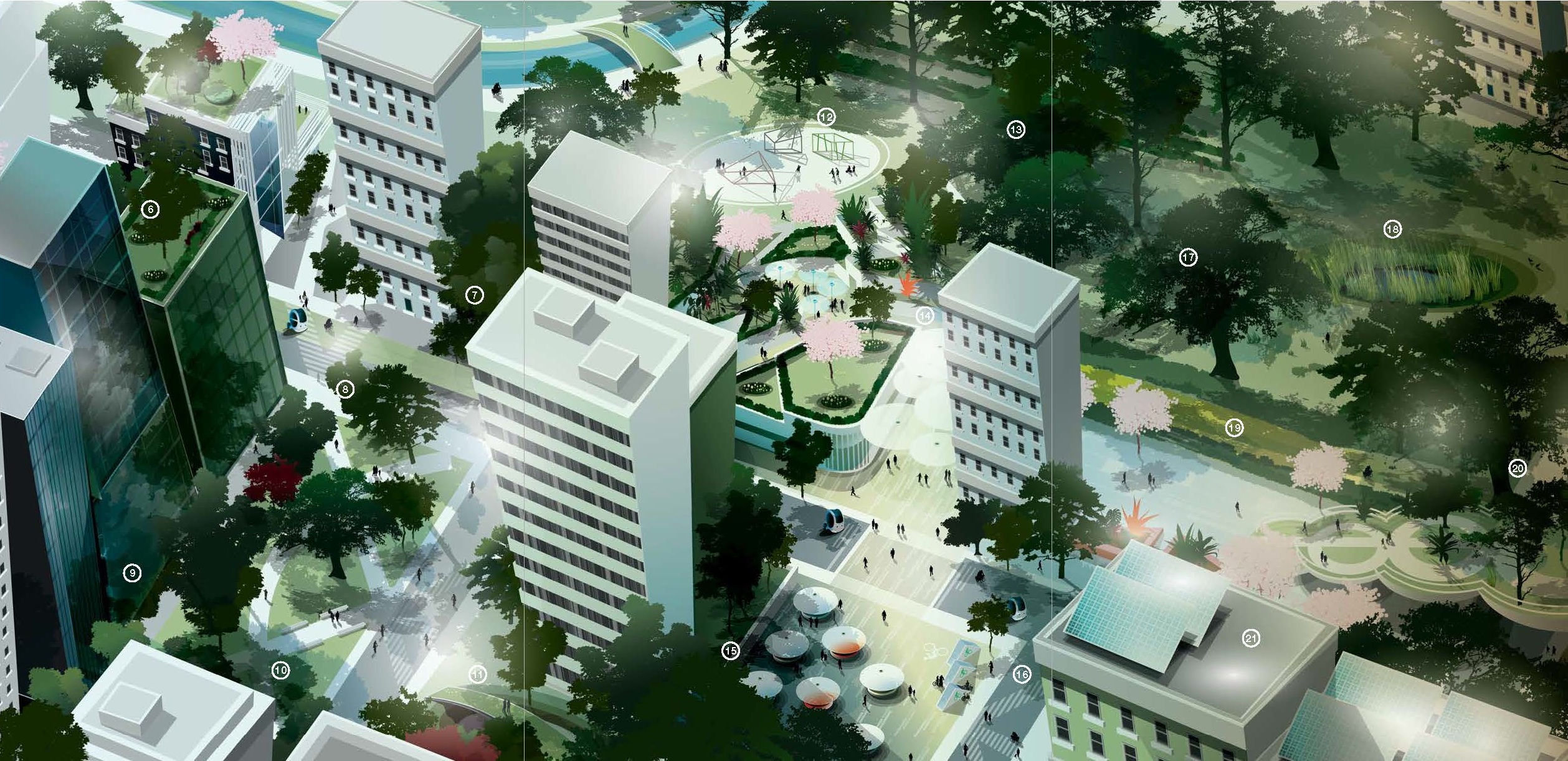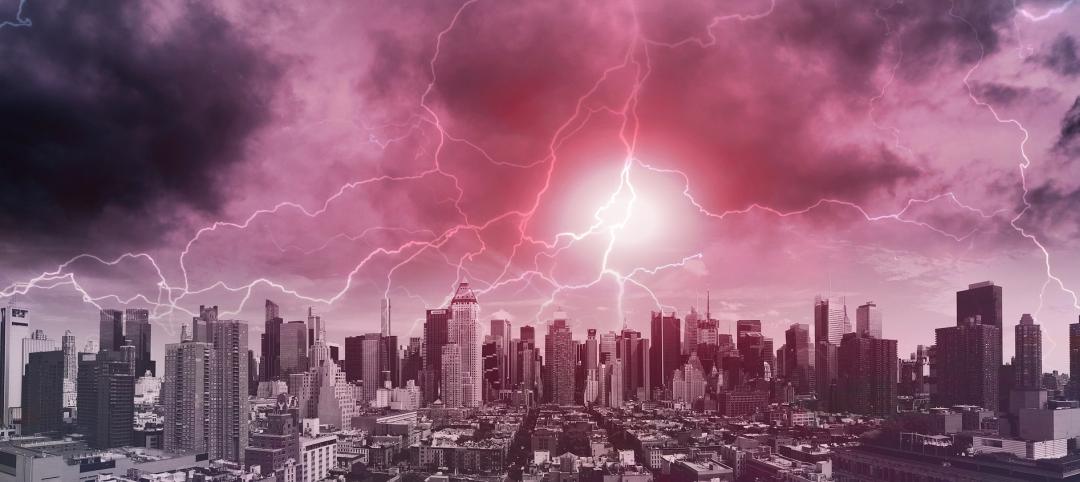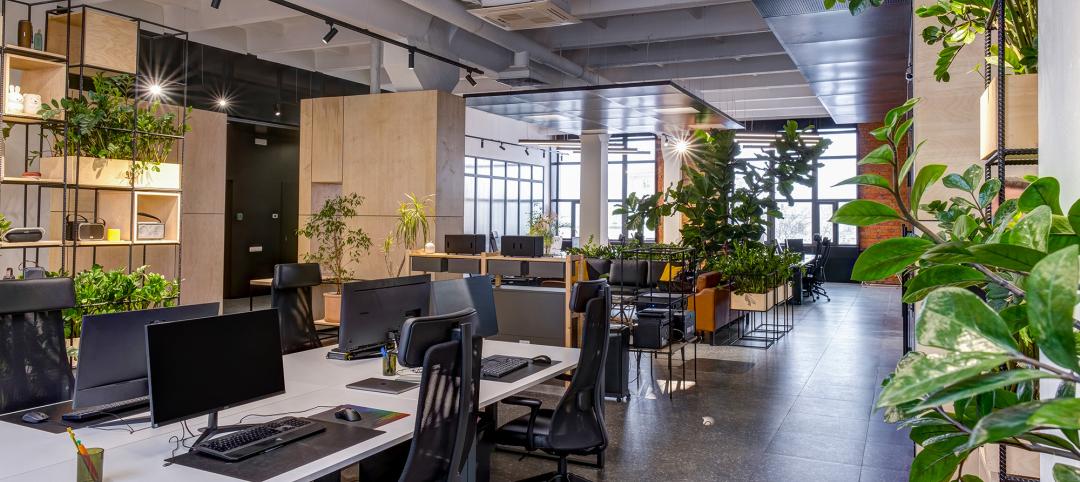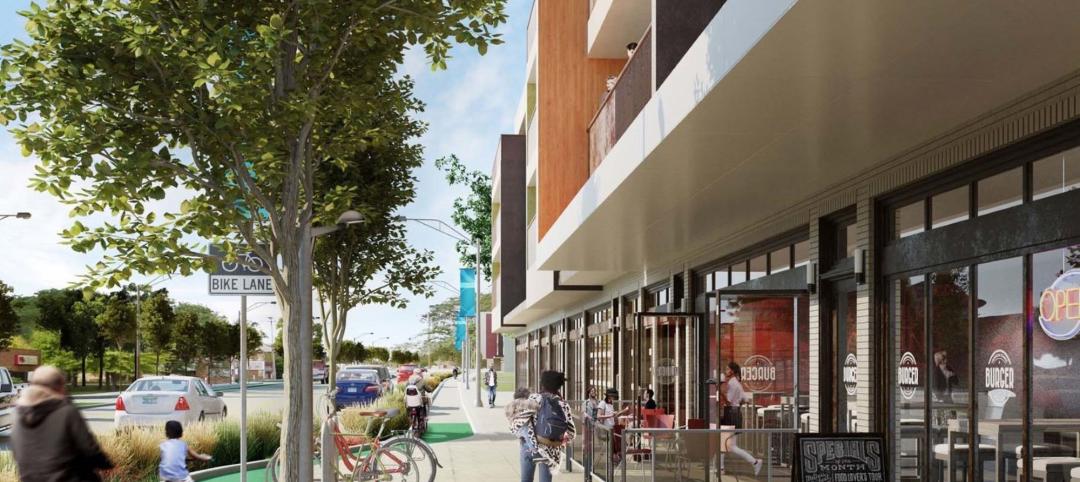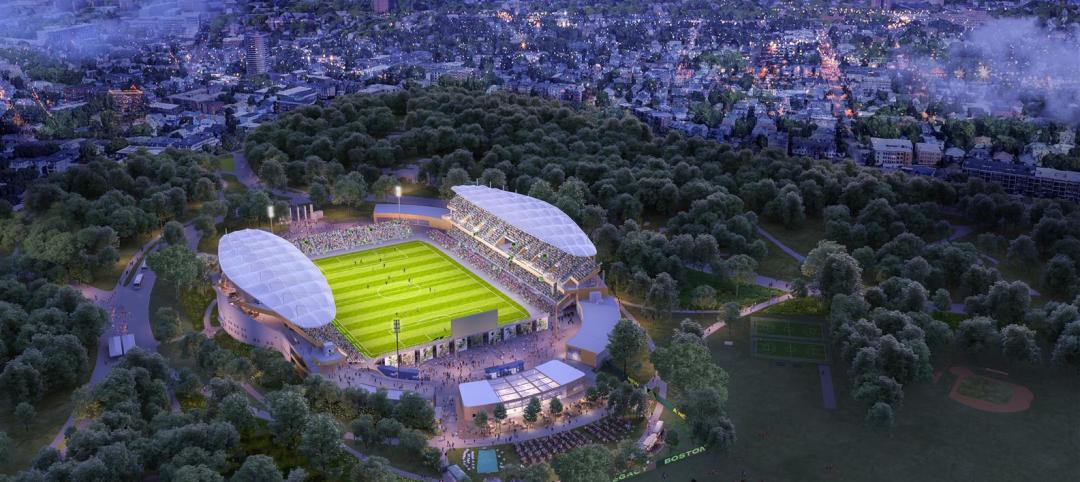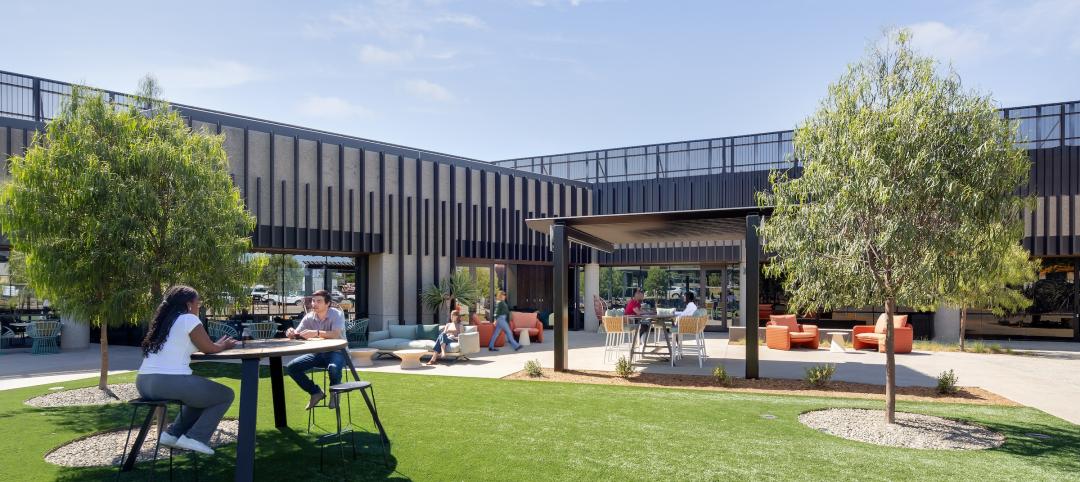A new report by engineering giant Arup analyzes current research and trends about green space in cities and how it can benefit urban communities socially, economically, and environmentally.
Cities Alive draws evidence from cities all over the world of how public spaces of all types can affect the security, happiness, and social life of residents.
The report is divided into three categories—social benefits, environmental benefits, and economic benefits—and details more than two dozen green infrastructure tactics, including underground roads, automated transport, permeable pavements, water roofs, vertical farming, and even glowing trees (see illustration below for a complete list).
Social Benefits: Rethinking Urban Communities
Safer driving — City trees can enhance traffic calming, the report says. Tall trees make streets seem narrower, which makes driver slow down. Meanwhile, close spacing of trees creates the illusion of speed, causing the same slowing effect.
Psychological benefits — Research cited in the report suggests that people are calmer and happier when they can experience nature on a daily basis. "Even passive interaction with nature—simply being able to see a tree through a window—is enough to lower stress and blood pressure," Cities Alive says.
Lower crime — Research cited in the report reflects a trend of lower crime rates in communities where vacant lots are turned into green spaces, as opposed to communities where these lots remain vacant and undeveloped.
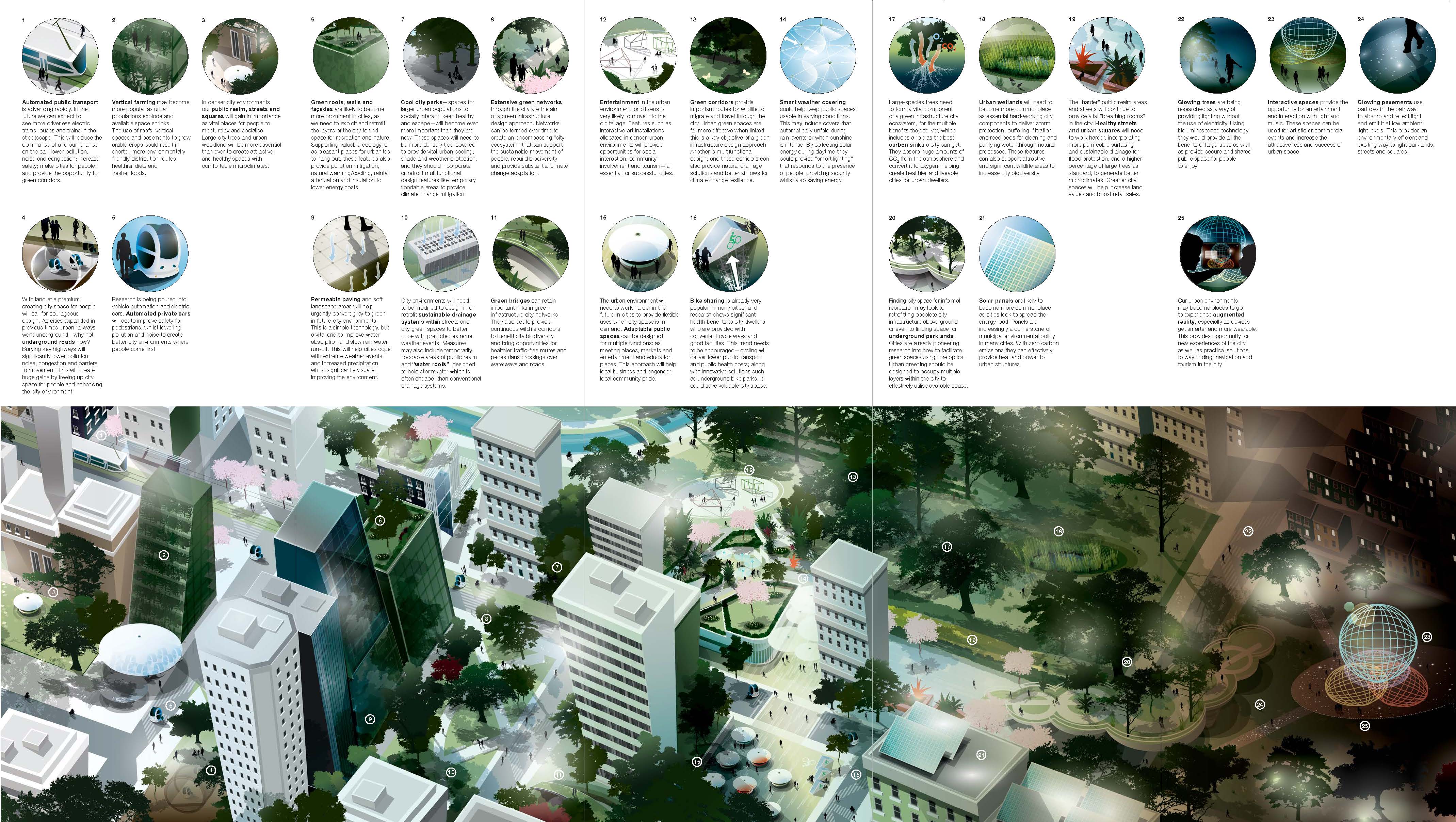
The report details 25 tactics cities can employ to improve their green infrastructure. Illustration: Arup's Cities Alive report. CLICK IMAGE TO ENLARGE
Better community social life — The more effective the design of the community, the more residents can build a tradition of social interaction in its spaces.
Space with an identity — Removing public spaces seems to be a factor in recent political unrest, and these spaces can foster protest communities and encourage democratic involvement: "...the wave of unrest that gripped Turkey in early 2013 began as a result of government policy decisions to remove and develop on top of public parks, particularly centred on Gezi Park in Istanbul. Here the green space became a place for a unique and empowered community to evolve and a place for them to call their own, much like the parallel Tahrir Square in Egypt or Zucotti Park in New York acting as the centre of the global Occupy movement."
Green space can encourage feelings of security — Research from the University of Illinois showed that people who have daily contact with nature, specifically trees, had stronger relationships with their communities and experienced 52% less crime than those without that daily dose of green.
Thoughtful planning can revitalize urban shopping spaces — "Studies have shown that well-planned rebranding of urban shopping spaces can increase commercial trading by up to 40%."
Green space can increase productivity — When an office has a view of green space, the report says, people in those offices may take as much as a quarter less time off as opposed to people without a view of green space.
Environmental Benefits: Smart and Resilient Environments
Coping with increased rainfall — With climate change causing more rainfall in many places, municipalities need to come up with more effective stormwater drainage systems. There are examples of this occurring already, in Portland, Ore., and other places.
Better urban planning in the face of climate change — Flooding is now a bigger issue in urban areas than ever. As a result, "new urban planning models suggest that where appropriate, space should be allocated for water-sensitive urban design (WSUD), and features such as new water bodies, reed beds, and areas of ground percolation can also be designed for buffering, water filtration, and drainage. These types of integrated GI solutions can create attractive new natural features in the city environment while also offering climate change adaptation."
Urban planners may need to begin maximizing data sharing in public spaces — Data may begin to add another layer of entertainment in public spaces—people may gather to watch movies or play video games together, just as they gather now for concerts or parades.
Virtual environments may become a reality — Where space is simply too limited to create green areas, projects like Yanko Design’s D’Nature modular digital greenspace may act as a supplement to existing greenery.
Geographical Information Science (GIS) can allow for smarter urban planning — From the report: "GIS uses overlays of different factors of a landscape to calculate optimized layouts for a variety of land uses, from agriculture to ecological potential, calculating best travel routes and the potential for alternative future applications for the space."
Biodiversity is necessary to the health of the planet — Not only is biodiversity necessary to ecological health, the report says, but it "is a great indicator of the ideology of a development. It can be a gateway to other green techniques and technologies that can help to sustain the urban ecosystem as a whole."
Designers should use the different layers of the city to allow as much green space as possible — By exploiting space such as that on roofs, balconies, and walls, designers can work within dense urban environments without destroying what little nature still remains. The High Line in New York City is cited as an example of this.
Economic Benefits: Urban Resource Streams
Vertical farming may be able to address global food shortages — Vertical farming is the idea of containing food production, harvesting of green energy, and a closed feed system with limited distribution and transportation requirements. This creates a minimal carbon footprint and means that the 'farm' can merge with the existing urban structure.
The Biophylia Hypothesis and Urban Food Supplies — From the report: "Proponents of the Biophilic City maintain that better education about the possibilities of urban foraging and guidelines promoting wild vegetation for human wellbeing may lead to a revolution in the way people interact with the city, introducing a new, wild urban consumer ecosystem into which urbanites are fully integrated."
Making urban spaces healthier, quieter, and more beautiful — Tearing down highways and buildings to reclaim waterfronts and parklands is possible and an important way to improve the quality of life in cities.
Movement toward locally sourced, traditional materials — Both the desires of reducing carbon footprints and creating more authentic spaces has led many architects and designers to seek out locally-sourced construction materials.
Integrating living ecosystems into the city — Incorporating more trees into urban landscapes can assist with heat, pollution, and air quality, as well as reducing energy bills by decreasing the need for air conditioning.
New green construction materials can help make cities more sustainable — For example, 'green concrete' that absorbs carbon from the surrounding environment and stores thermal energy is being researched.
Related Stories
MFPRO+ New Projects | Oct 30, 2024
BIG’s One High Line finally reaches completion in New York City’s West Chelsea neighborhood
One High Line, a luxury residential project spanning a full city block in New York’s West Chelsea neighborhood, reached completion this summer following years of delays related to investor lawsuits.
Urban Planning | Oct 30, 2024
Bridging the gap: How early architect involvement can revolutionize a city’s capital improvement plans
Capital Improvement Plans (CIPs) typically span three to five years and outline future city projects and their costs. While they set the stage, the design and construction of these projects often extend beyond the CIP window, leading to a disconnect between the initial budget and evolving project scope. This can result in financial shortfalls, forcing cities to cut back on critical project features.
MFPRO+ New Projects | Oct 30, 2024
Luxury waterfront tower in Brooklyn features East River and Manhattan skyline views
Leasing recently began for The Dupont, a 41-story luxury rental property along the Brooklyn, N.Y., waterfront. Located within the 22-acre Greenpoint Landing, where it overlooks the newly constructed Newtown Barge Park, the high-rise features East River and Manhattan skyline views along with 20,000 sf of indoor and outdoor communal space.
Libraries | Oct 30, 2024
Reasons to reinvent the Midcentury academic library
DLR Group's Interior Design Leader Gretchen Holy, Assoc. IIDA, shares the idea that a designer's responsibility to embrace a library’s history, respect its past, and create an environment that will serve student populations for the next 100 years.
Resiliency | Oct 29, 2024
Climate change degrades buildings slowly but steadily
While natural disasters such as hurricanes and wildfires can destroy buildings in minutes, other factors exacerbated by climate change degrade buildings more slowly but still cause costly damage.
Office Buildings | Oct 29, 2024
Editorial call for Office Building project case studies
BD+C editors are looking to feature a roundup of office building projects for 2024, including office-to-residential conversions. Deadline for submission: December 6, 2024.
Healthcare Facilities | Oct 28, 2024
New surgical tower is largest addition to UNC Health campus in Chapel Hill
Construction on UNC Health’s North Carolina Surgical Hospital, the largest addition to the Chapel Hill campus since it was built in 1952, was recently completed. The seven-story, 375,000-sf structure houses 26 operating rooms, four of which are hybrid size to accommodate additional equipment and technology for newly developed procedures.
Multifamily Housing | Oct 28, 2024
A case for mid-rise: How multifamily housing can reshape our cities
Often referred to as “five-over-ones,” the mid-rise apartment type is typically comprised of five stories of apartments on top of a concrete “podium” of ground-floor retail. The main criticism of the “five-over-one” is that they are often too predictable.
Sports and Recreational Facilities | Oct 24, 2024
Stadium renovation plans unveiled for Boston’s National Women’s Soccer League
A city-owned 75-year-old stadium in Boston’s historic Franklin Park will be renovated for a new National Women’s Soccer League team. The park, designed by Fredrick Law Olmsted in the 1880s, is the home of White Stadium, which was built in 1949 and has since fallen into disrepair.
Laboratories | Oct 23, 2024
From sterile to stimulating: The rise of community-centric life sciences campuses
To distinguish their life sciences campuses, developers are partnering with architectural and design firms to reimagine life sciences facilities as vibrant, welcoming destinations. By emphasizing four key elements—wellness, collaboration, biophilic design, and community integration—they are setting their properties apart.


